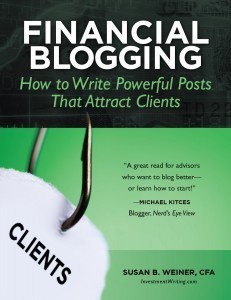Susan B. Weiner's Blog, page 60
June 2, 2015
Work smarter, not harder, on your blog

My book can help you to work smarter, not harder, on your blog. See what happy readers say on Amazon: http://ht.ly/o0d7t
You’re a busy professional. You don’t have unlimited time to devote to your investment or financial planning blog. However, if you’re blogging without a strategy or plan, you’re wasting time. Advance preparation, as I explain below, will allow you to work smarter, not harder, on your blog.
Step 1. Know your goals.
Do as I say, not as I do, when it comes to blogging. I wasted time on two earlier blogs until I found my focus in helping financial marketing professionals learn to write better.
You’ll achieve better results if you start by identifying your target audience and your topic areas. Both should align with your business focus. For example, if you offer financial planning to divorced women in their fifties or older, don’t write blog posts for Millennials about how to start saving in a Roth IRA account.
Step 2. Pick the right blogging frequency
Consistency counts when you blog. Your clients won’t be impressed if you blog twice a day for one month, quarterly for a year, and then sporadically thereafter. They’ll worry that you bring the same lack of commitment to your main business, as I discussed in “Woody Allen’s wisdom for successful financial bloggers.”
Pick a posting frequency that you can stick with. Not sure how often you can post? Create a cache of posts that aren’t time-sensitive before you go public with your blog.
Step 3. Develop a process
When you develop a repeatable process for your blog, you’ll invest less energy in creating each post. This is why my book, Financial Blogging: How To Write Powerful Posts That Attract Clients gives you step-by-step instructions for the following topics:
Brainstorming ideas
Organizing your thoughts before you write
Writing your first draft
Making “big picture” edits
Making smaller edits
The book also discusses compliance, marketing, and time management.
After you develop a process that works for you, your blog posts will take shape more quickly and easily.
Step 4. Learn your blogging personality
Different approaches to blogging work best for different people. Pay attention to what works best for you, so you can do more of those things.
For example, some people enjoy writing to a detailed editorial calendar, as I described in “How to manage a group blog: Financial advisor edition.” But that approach would be like torture for me. I need some inspiration to write.
I’ve identified some techniques that work well for me. For example
Maintaining a list of potential topics in Microsoft Outlook
Mind mapping complex topics
Writing drafts in a steno pad, as described in “No batteries required: My favorite blogging technique”
Don’t force yourself to use techniques you don’t enjoy—especially when better alternatives exist.
Step 5. Get help
You don’t have to do it all yourself. For example, Sheri Iannetta Cupo of Sage Advisory Group, LLC uses the help of Wendy Vissar to create customized images for her blog, as explained in “Boost your blog with original photos: The SAGE Advisory example.” Rick Kahler of Kahler Financial uses an editor. Some advisors have used the services of Wired Advisor to help with the design and development of their blogs. You can use my Financial Blogging book as a source of ideas for how to overcome common challenges for bloggers.
I’m not a big fan of hiring a ghost blogger. You’ll do better by letting your personality shine through in something you’ve written. You can adapt your posts to suit your skills and preferences. For example, you can write very short, opinionated pieces. Or you can create podcasts or videos.
If you’re determined to use content written by others, check out the resources in “Ready-to-use content for financial advisors.”
It’s rare for me to take on ghost-blogging outside of ongoing relationships with larger companies. However, you can hire me to critique one of your blog posts so you can learn to improve future posts.
What are YOUR best tips?
I’d like to see your best tips for working smarter, not harder, on your blog.
______________________________________________________________________
Learn to write better! Register for Susan’s June 22 webinar on “How to Write Investment Commentary People Will Read” or buy Financial Blogging: How to Write Powerful Posts That Attract Clients.
Copyright 2015 by Susan B. Weiner All rights reserved
This content may not be reposted without the author’s written permission.
The post Work smarter, not harder, on your blog appeared first on Susan Weiner's Blog on Investment Writing.
June 1, 2015
Reader question: How to get writers to follow style guidelines?
Marketing and communications professionals at financial firms face a challenge. They understand the importance of well-written content that follows style  guidelines to be reader-friendly. However, they often depend on experts outside the marketing department to generate that content. Investment and wealth management professionals may not know or care about style guidelines. When they fail to abide by style guidelines, they create headaches for their readers and their colleagues.
guidelines to be reader-friendly. However, they often depend on experts outside the marketing department to generate that content. Investment and wealth management professionals may not know or care about style guidelines. When they fail to abide by style guidelines, they create headaches for their readers and their colleagues.
How can marketers get cleaner copy from their colleagues? This is essentially what one reader asked me in the following message:
How can we implement and maintain style guidelines across a company, generating and maintaining buy-in and compliance?
I brainstormed with some colleagues and took inspiration from Switch, a book by Chip and Dan Heath, to suggest steps to improve your colleagues’ compliance with style guidelines.
1. Offer style guide training
Ignorance is bliss. At least, that may be true for your colleagues. They can’t abide by guidelines of which they’re unaware.
Provide training on your style guidelines. A short session focused on the most important guidelines will probably attract the greatest attendance and get the best results.
Consider folding your discussion of guidelines into a broader discussion of how to write better or faster. The topic of style guidelines doesn’t excite most people. However, improving one’s skills as a writer helps to build the student’s ability to influence people and advance his or her career.
Hiring an outsider to deliver training can spare the marketing department from playing a bad guy role as an enforcer. Plus, you can exploit the authority of an outsider who knows your industry. Check out my training options, including my webinar on “How to Write Investment Commentary People Will Read.”
2. Make your style guide easily accessible
Make it easy for employees to find your firm’s style guide. This may mean putting it on a shared drive so everyone can access the most recent version.
If you lack a shared drive, consider regularly circulating the most current version with a note highlighting the guidelines that are most important to your firm.
3. Provide different levels of detail, depending on the audience
Your typical financial professional will not use a long style guide that the marketing department views as an essential tool. It’s too much information. It’s overwhelming.
Instead, give your firm’s financial professionals a short document that highlights your most important style guidelines.
Another possibility is to offer them a checklist for reviewing their work before handing it in. My Financial Blogging book includes a checklist that can be customized to an individual writer’s needs.
4. Provide templates that follow style guidelines
If your colleagues make mistakes on standardized documents, then provide templates for them. For example, let’s say that you want them to use the ® mark on their first reference to the Standard & Poor’s 500 Index. Provide a template that includes “Standard & Poor’s® 500 Index” to spare them from thinking about the correct usage. Alternatively, you can ask them to start their new document from a cleaned-up version of the previous document.
5. Start a buddy system
It’s hard for most writers to catch their own mistakes. Consider starting a buddy system, where your financial professional’s check one another’s text before submitting it to marketing. Of course, during busy periods, such as quarterly reporting crunches, it may be hard for them to make time for this.
6. Offer “carrots”
Can you offer a reward to employees who improve their writing or meet certain standards? The reward could be something as simple as recognition in your employee newsletter.
7. Explain how style mistakes affect client service and acquisition
Your firm’s financial professionals may not understand how their mistakes affect your firm’s relationships with clients and prospects. Tell them.
First, if you let mistake-riddled work reach clients and prospects, you undermine your firm’s credibility. A firm that doesn’t care about blatant typos may show a similar disregard for the details of their portfolio accounting or financial plans. That worries clients and prospects.
Second, the need for extensive proofreading and copyediting delays the publication of your firm’s content. A relatively clean piece of content from a writer who consistently observes style guidelines can quickly earn the marketing department’s approval. On the other hand, a piece that’s riddled with errors requires more time and possibly multiple reviews, as editors struggle to fix it. This delays content from reaching the firm’s audience.
8. Use techniques from Switch
In Switch, by Chip and Dan Heath, the authors tackle a similar kind of problem, how to get employees to file their expense reports on time. The Heaths note that nagging emails don’t work. They may even reinforce the perception that everyone ignores the style guidelines. However, they have some suggestions. which I gathered from the end of their “Script the Critical Moves” chapter.
Learn from success stories
The Heaths suggest that instead you look at the people who are doing things right. What are they doing differently? In the expense example, “Maybe they’ve handcrafted a set of techniques for logging expenses as they occur, so there’s not a big pile left at the end of the month,” say the Heaths. “Get them to share their system with others.”
Make it easy for people to comply
Another tip: “Script the critical moves” to remove ambiguity that paralyzes people. This can be tough with issues of style. Perhaps it means that the marketing department asks writers to observe some clear rules, while tackling the tough rules itself during the proofreading process. Giving employees a simple checklist might achieve this.
Provide motivation
“Find the feeling,” suggest the Heaths. That could mean trading on your employees’ feelings for their colleagues. In the expense report example, the Heaths suggest telling people how their actions prevent a colleague from meeting her deadlines. “It may be easy to rationalize missing an administrative deadline, but it’s harder to rationalize letting down a co-worker who’s counting on you,” say the Heaths.
With style guidelines, employee lapses may handicap client services and sales personnel, in addition to marketing staff.
Highlight compliance
“Rally the herd,” say the Heaths, because “people are sensitive to social norms.” If you highlight employees’ compliance with guidelines, you’ll encourage others to follow. As they say, “No one likes to hear they’re underperforming their peers.”
9. Be realistic
You can’t achieve 100% compliance with your style guidelines. Your financial professionals have lots of other demands on their time. Also, it’s hard for most people to catch errors in their own work. A smart marketing department will proofread its writers’ work.
However, you can boost the quality of your colleague’s work by applying some of the tips discussed above.
What are YOUR best tips?
If you’ve tackled this challenge, please share your tips. I’m also interested in hearing from financial professionals about how marketers can make it easier for you to create high quality materials.
If you’re a marketer, you may also enjoy “Reader question: How can communicators manage difficult portfolio managers?”
Image courtesy of stockimages at FreeDigitalPhotos.net
Disclosure: If you click on the Amazon link in this post and then buy something, I will receive a small commission. I only link to books in which I find some value for my blog’s readers.
______________________________________________________________________
Learn to write better! Register for Susan’s June 22 webinar on “How to Write Investment Commentary People Will Read” or buy Financial Blogging: How to Write Powerful Posts That Attract Clients.
Copyright 2015 by Susan B. Weiner All rights reserved
This content may not be reposted without the author’s written permission.
The post Reader question: How to get writers to follow style guidelines? appeared first on Susan Weiner's Blog on Investment Writing.
May 28, 2015
Reader question: How do we get people to read to the end?
“How do we get people to read to the end of our newsletter articles and blog posts?” This question came up in one of my writing workshops.
I share some ideas in this article. I also suggest that you complement this goal by asking “How can we ensure that people who don’t read to the end—or who don’t read every paragraph—still grasp our main points?”
1. Write in a reader-friendly way
To attract and retain your readers throughout your articles, write in a reader-friendly way.
This starts with clearly identifying your topic and how it’ll help your reader. Do this in your introduction to snare readers.
Next, write headings that guide your reader through your article. These should show how your article will deliver on the promises made in your introduction.
Observe other good writing practices, such as strong topic sentences and clear, concise writing. Clunky writing discourages readers.
2. Use “gold coins”
Readers tend to bail out of reading online after less than two minutes. That’s the point where Poynter’s Eyetrack research suggests “establishing a ‘gold coin’ like a simple pullout quote or visual element that keeps the reader engaged about halfway through a long story.” This could be a provocative quote, graph, or photograph. Or it could be “a telling detail, a bit of description, an apt phrase, a moving anecdote,” as Dr. Ink says in “Dr. Ink Discovers the Sixth ‘W’.” As Dr. Ink says, “If these are spaced strategically in the story, the logic goes, the reader will have incentive to move down the path. As soon as the gold coins run out, the reader leaves the forest.”
Bonus: Capture readers who skim
It’s not realistic to get every reader to finish each of your articles. However, if you observe the tips listed above, you’ll get more mileage out of your articles. This is because you’ll communicate well with those who only skim. They can still grasp the gist of your articles.
Image courtesy of foto76 at FreeDigitalPhotos.net
______________________________________________________________________
Learn to write better! Register for Susan’s June 22 webinar on “How to Write Investment Commentary People Will Read” or buy Financial Blogging: How to Write Powerful Posts That Attract Clients.
Copyright 2015 by Susan B. Weiner All rights reserved
This content may not be reposted without the author’s written permission.
The post Reader question: How do we get people to read to the end? appeared first on Susan Weiner's Blog on Investment Writing.
May 26, 2015
Are you crediting your OECD data properly?
You can’t simply grab data for use in your white papers, articles, and blog posts. You may not have the right to use as much of the information as you like, as I’ve explained in “Legal  danger for financial bloggers: Two misconceptions, three resources, one suggestion.” Assuming it’s okay to use the data, you need to give the proper credit for it. Some data providers ask for more than others, as I discovered when I looked at the website of the Organisation for Economic Co-operation and Development (OECD). OECD data is often cited in white papers of investment and wealth management firms.
danger for financial bloggers: Two misconceptions, three resources, one suggestion.” Assuming it’s okay to use the data, you need to give the proper credit for it. Some data providers ask for more than others, as I discovered when I looked at the website of the Organisation for Economic Co-operation and Development (OECD). OECD data is often cited in white papers of investment and wealth management firms.
In this post, I describe some steps you can take to use OECD data according to its guidelines. Please check directly with the organization if you have questions. They’re the authority on the use of their data.
1. Check to see if you need permission
Below is what I found on the OECD website about using its data:
You can copy, download or print content for your own use, and you can also include excerpts from OECD publications, databases and multimedia products in your own documents, presentations, blogs, websites and teaching materials, provided that suitable acknowledgment of OECD as source and copyright owner is given. You should cite the Title of the material, © OECD, publication year (if available) and page number or URL (uniform resource locator) as applicable.
All requests for commercial use and translation rights should be submitted to rights@oecd.org.
This description is vague enough that I wondered if you can use OECD data in a white paper without paying a fee. After all, white papers seems like commercial use to me. I found a pretty broad definition of commercial use on TheHelpful.com. My philosophy about using copyrighted data is “When in doubt, ask for permission.” I emailed the OECD to ask if it’s okay to use its data in a white paper with attribution.
2. Work within the OECD’s constraints
Here’s the part of the reply I received from an individual in the OECD’s rights area.
Thank you for your message. There are no objections concerning the reproduction of OECD data (values) to create your own graphs/tables/charts provided that suitable acknowledgment of OECD as source and copyright owner is given. The material should be cited as follows : Based on data from OECD, title of the dataset, title of the database, friendly url, date of access
It seems as if you are free to cite some data in your text and even to create your own graphs, tables, and charts using the OECD’s data. Make sure those exhibits are truly your own. You can’t simply reproduce OECD exhibits.
Make sure you give proper credit in your exhibits based on OECD data. I’m guessing that the OECD’s preferred citation, “Based on data from OECD, title of the dataset, title of the database, friendly url, date of access,” goes into more detail than many writers commonly provide. However, you probably should have those details available anyhow to keep your firm’s compliance professionals happy.
3. Contact the OECD if you seek to reproduce materials or make commercial use
Found a great OECD graph, chart, or document that you’d like to reproduce? Play it safe by contacting the OECD for permission. Here’s what the OECD told me about rights requests.
Should you wish to use OECD data/reproduce OECD published material for commercial purposes, please send us more information about your intended use by completing the following form:
About the OECD material you want to reproduce:
Full title:
Publication date:
ISBN:
Internet address (if applicable):
Exact pages / charts / data to be reproduced:
Will you translate the material? If yes, into which language?
About you:
Name:
Full address:
Email:
About your work:
Title:
Number of pages*:
Planned publication date :
Publisher’s name, address:
Print Run*:
Public Price*:
If published online:
Number of subscribers*:
Price of the subscription*:
* even if approximate
Comments (if any):
Stay safe by following the rules when you cite other people’s data! Contact the OECD if you have any questions.
Image courtesy of adamr at FreeDigitalPhotos.net
______________________________________________________________________
Learn to write better! Register for Susan’s June 22 webinar on “How to Write Investment Commentary People Will Read” or buy Financial Blogging: How to Write Powerful Posts That Attract Clients.
Copyright 2015 by Susan B. Weiner All rights reserved
This content may not be reposted without the author’s written permission.
The post Are you crediting your OECD data properly? appeared first on Susan Weiner's Blog on Investment Writing.
May 21, 2015
Help employees write financial content for publication
Publishing investment and financial content isn’t just for the big names any more. In the old days, only chief investment officers and senior executives put their  names on articles published by investment, wealth management, and financial planning firms. This was true even when junior employees, marketing communications staff, or freelancers did the writing. Today, the needs of search engine optimization, social media and blogging, plus the demand for more personal, less bland content are changing the rules. Firms are asking more employees to write for their blogs, newsletters, and other publications.
names on articles published by investment, wealth management, and financial planning firms. This was true even when junior employees, marketing communications staff, or freelancers did the writing. Today, the needs of search engine optimization, social media and blogging, plus the demand for more personal, less bland content are changing the rules. Firms are asking more employees to write for their blogs, newsletters, and other publications.
This creates challenges, as well as opportunities, for financial firms. How can they engage more employees in writing for publication? How can they ensure that the content is good enough?
Most financial services employees aren’t hired for their writing skills. Some are gifted idea generators and wordsmiths. Others don’t enjoy writing and haven’t been trained to write well.
I have suggestions on how to inspire your employees to write more and better. If you need practical help right away, send your employees to my webinar on “How to Write Investment Commentary People Will Read,” scheduled for June 22, 2015 (Early Bird rate ends June 3).
1. Set a good example at the top
Employees notice senior executives’ actions. When your executives publish regularly, they set a good example for the rest of the firm.
Senior management can also help by recognizing the contributions of their juniors. Recognition can take many forms:
Sharing content on social media—by the way, don’t underestimate the value of you and your employees sharing on social media, as my photo from social media expert Neal Schaffer’s May 7, 2015 presentation shows.
Praising individuals for their contributions
Featuring contributions by junior employees, as well as senior management, in a newsletter or blog
Including writing as part of job descriptions and performance reviews
2. Offer ideas to jumpstart employee writing
Some people, even veteran writers, get stuck at the stage of generating ideas or starting to put words on the page. You can help them by suggesting topics or providing models for their pieces.
A. Suggest specific topics
When you suggest topics, try to be as specific as possible, especially if you’re helping a new writer. Instead of suggesting the broad topic of “market timing,” you might suggest
Why market timing isn’t right for retirees
Market timing or buy-and-hold—which is best?
Three reasons why market timing doesn’t work
Research shows benefits of market timing
A narrower suggestion gives your direction to your newbie writer. Of course, it requires you to have some knowledge of the topic so you don’t steer them wrong.
B. Provide models
Facing a blank page can intimidate writers at all levels of experience. To relieve their stress, provide your writers with models to follow. Give them examples of articles that you like. The examples can be from your firm or elsewhere. I provide one fill-in-the-blanks model on my blog.
3. Train your employees to write

Click on image to register
Training can help your employees to overcome their fear of writing and to write better and faster. I train corporate clients and members of professional societies to write better. However, any kind of writing class, even at a local education program can help. I got much of my early training in programs offered by the Boston, Cambridge and Newton adult ed programs.
If you’d like online training, check out my webinar on “How to Write Investment Commentary People Will Read.”
It’s also good to provide training about compliance rules. For example, writers can’t guarantee returns or promise that certain things will happen. Also, some topics, especially discussion of specific products, may demand disclosures. Consider providing your employees with compliance checklists so they avoid violating compliance rules.
4. Provide editing and proofreading
Typos and other mistakes undercut the credibility of your content. It’s hard for most writers to proofread themselves. This is why I suggest you use a proofreader-copy editor.
If your budget permits, hire a professional proofreader-copy editor. This could be someone in your marketing department or a freelancer. If it’s a freelancer, think about whether you want someone with financial expertise who can catch content problems. If your budget is tight, go for someone who only knows grammar and usage.
5. Reward participation
Employees like to do things that are rewarded and praised. When you recognize the contributions of your employee-writers, you’ll encourage more participation.
YOUR thoughts
How do you encourage your investment or wealth management professionals to write? Please tell me.
Image courtesy of Stuart Miles at FreeDigitalPhotos.net
______________________________________________________________________
Learn to write better! Hire Susan to critique your writing or buy Financial Blogging: How to Write Powerful Posts That Attract Clients.
Copyright 2015 by Susan B. Weiner All rights reserved
This content may not be reposted without the author’s written permission.
The post Help employees write financial content for publication appeared first on Susan Weiner's Blog on Investment Writing.
May 19, 2015
Changing your instructions is risky
My long-suffering husband has a communications lesson for you. Recognize that your first message is most easily absorbed by your listeners. If you change your message midstream,  your listeners may not hear you. To make sure your message gets across, ask them to confirm their understanding of the new message.
your listeners may not hear you. To make sure your message gets across, ask them to confirm their understanding of the new message.
“Park your car outside the garage tomorrow, so I can get my tires,” said my husband on a Thursday morning. Okay, I said. We spoke a bit more. I guess my attention strayed because I ran into trouble the next day.
On Friday, I parked where my husband had indicated. However, when my husband arrived home, he asked “Why did you park there?”
Me: “Because you asked me to.”
Husband: “No, I told you that you didn’t have to park there after all.”
Me: “You did?” Apparently my husband’s changed instructions hadn’t registered in my head. Perhaps I was trying to make up for my poor performance that I described in “Instructions for a bad wife.” I should have confirmed my understanding at the end of our conversation. I’ll do that next time. At least, I’ll try. I seem to have a blind spot for my husband’s parking instructions.
What’s the lesson for you?
If you change your mind after giving initial instructions, don’t count on your listeners absorbing the new information. This might apply, for example, if you start by suggesting selling one fund, but then switch to another recommendation.
What can you do to reinforce your change?
Repeat your new instructions.
Explain why you changed your mind.
Ask your listeners, “Do you understand my new instructions?”
Consider putting your instructions in writing.
This may be overkill, if your listeners are more attentive than me with my husband. However, if the new instructions are important, you’ll be glad you took extra steps to ensure your listeners’ comprehension.
______________________________________________________________________
Learn to write better! Hire Susan to critique your writing or buy Financial Blogging: How to Write Powerful Posts That Attract Clients.
Copyright 2015 by Susan B. Weiner All rights reserved
This content may not be reposted without the author’s written permission.
The post Changing your instructions is risky appeared first on Susan Weiner's Blog on Investment Writing.
May 12, 2015
Write your lousy first draft!
I’m a big believer in organizing your thoughts before you start writing. However, please don’t wait until your thoughts are perfectly organized to start your first draft. Waiting for  perfection means you may never write anything. On the other hand, a lousy first draft can be a great starting point.
perfection means you may never write anything. On the other hand, a lousy first draft can be a great starting point.
A Margaret Atwood quote recently reminded me of the importance of starting to write.
If I waited for perfection, I would never write a word.
Do what you can to organize your thoughts first. You may write an outline, mull over ideas in your head, or draw a mind map, a technique that I explain in Financial Blogging: How To Write Powerful Posts That Attract Clients. Do what you can, but then move on.
The great thing about a draft—even a lousy first draft—is that it gives you material that you can fix. Also, the act of writing helps you to process your information. It’ll give you a better idea of what you’re trying to say.
Once you’ve drafted your piece—whether it’s as short as a tweet or as long as a white paper—you can analyze it. Look first at the big picture, as I describe in ”5 steps for rewriting your investment commentary.” Once you’ve fixed those issues, you can dig into the details.
If editing isn’t your strength, consider hiring an editor, like Sheri Fitts of ShoeFitts Marketing. When Sheri and I spoke on her “Women Rocking Wall Street” podcast, she told me that she sends her drafts to an editor. That’s a great use of outsourcing.
If you can’t afford an editor, ask a colleague, family member, or friend for feedback. Don’t let your desire for perfection stop you from writing. Start your draft today!
Image courtesy of photostock at FreeDigitalPhotos.net
______________________________________________________________________
Learn to write better! Hire Susan to critique your writing or buy Financial Blogging: How to Write Powerful Posts That Attract Clients.
Copyright 2015 by Susan B. Weiner All rights reserved
This content may not be reposted without the author’s written permission.
The post Write your lousy first draft! appeared first on Susan Weiner's Blog on Investment Writing.
May 7, 2015
Lessons from my headshot photo disaster

I am thrilled with this photo
Your headshot photo shows up a lot. It’s not only on your company’s website. It’s also on LinkedIn, Twitter, Facebook, Gmail, other social media, and other sites where you log in with your social media credentials or upload photos.
Your photo is part of your marketing so you want a photo that looks professional and attractive. It should also be recent enough that people can recognize you.
I learned some lessons from a failed attempt—and my eventual success—at updating my headshot photo. I hope they help you to do better the next time you update your photo.
1. Value the crowd’s wisdom in assessing your headshot photo
“Ugh, that’s me?” That was my reaction to viewing the proofs from my initial photo shoot. However, I know I’m very picky so I asked my friends, “Which photo do you like best?” Perhaps I could learn to like the crowd’s favorite.
One photo proved most popular, but so did suggestions that the photographer had photographed me at a bad angle and with unflattering lighting. The suggestions, which came from people whom I trusted, prompted me to present their comments to the photographer. In our email exchange, I learned that my friends were right. The photos were bad, due to the photographer’s response to my glasses.
2. Ask your headshot photographer about your glasses
Ask your photographer if your glasses will pose a challenge. This question hadn’t occurred to me. After all, the same photographer took a perfectly fine picture of me in my glasses some years ago. However, I learned after seeing my proofs that the photographer had had two problems with my current pair. First, my lenses turn dark in the sun. Second, they lack an anti-glare coating. To work around the reflections, the photographer made choices that didn’t flatter my appearance.
3. Fix the glasses problem
I arranged for a photo re-shoot and decided to do whatever I could to make it more successful.
My key move involved my glasses. To avoid the reflectivity problem, I got the lenses popped out of an old pair of glasses. The store where I bought the glasses did it for me, to avoid damaging the lenses.
If you wear glasses, but lack old frames, you have options:
Be photographed without glasses
Buy an inexpensive but attractive pair of reading glasses and remove the lenses
Ask your photographer to use some of the tips in “10+ tips for photographing people in glasses and avoiding glare“
4. Fix other problems
You can also tackle other issues, such as clothing, hair, and makeup. In a sense, I was lucky because my bad headshot let me work on issues that weren’t caused by the photographer’s lighting or angle.
Your issues will differ from mine, but here’s what I did for my headshot photo re-shoot:
Picked a jacket that fit better
Added a red scarf to flatter my coloring
Wore brighter lipstick and more blush—I was already wearing more makeup than usual
Grew my bangs longer—my hair stylist had despaired of getting me grow them longer since I like to keep my hair out of my face, but seeing my initial round of photos convinced me that she was right
Made an appointment to get my hair professionally blow-dried the morning of my photo shoot instead of doing it myself—I even got the bit of the gray in my hair professionally colored because I found it distracting in the initial round of photos
Brought a friend with me to the photo shoot to help me relax so my smile would be reflected in my eyes as well as my mouth—as a bonus, the friend also arranged my scarf far better than I would have done on my own
YOUR photo tips?
I’m not a photo pro. If you have tips for great headshot photos, please share.
Here are some links that a photo-savvy friend, Dianne Highbridge, author of In the Empire of Dreams, a novel about expatriates in Tokyo, sent me:
How to Look Better in Photos Based on Your Body Type
Video: It’s all about the Jaw—it’s amazing how big a difference positioning makes
______________________________________________________________________
Learn to write better! Hire Susan to critique your writing or buy Financial Blogging: How to Write Powerful Posts That Attract Clients.
Copyright 2015 by Susan B. Weiner All rights reserved
This content may not be reposted without the author’s written permission.
The post Lessons from my headshot photo disaster appeared first on Susan Weiner's Blog on Investment Writing.
May 4, 2015
How to beat blog burnout
Have you ever felt tired of blogging? Thought about giving up your blog? I have. There was a month when I hated all of my new posts and felt enthusiasm about no potential topics. My  energy had been flagging for awhile. I say that because “blog burnout” flashed into my head when I saw this statue on Michelangelo’s tomb in the Basilica of Santa Croce in Florence, Italy.
energy had been flagging for awhile. I say that because “blog burnout” flashed into my head when I saw this statue on Michelangelo’s tomb in the Basilica of Santa Croce in Florence, Italy.
I pulled myself out of my slump. Perhaps you, too, can beat your blogging blahs with the techniques I share below.
1. Reexamine why you’re blogging
Take a new look at why you’re blogging. If your business has changed, perhaps your blog is no longer worthwhile. Consider dropping it. It felt liberating to considering dropping my blog as part of my goal-setting process.
However, that positive feeling turned to horror, as I considered losing my readers and my chance to express myself on topics about which I feel strongly. My readers and my passion for clear, effective communications are reasons why I continue to blog.
2. Ask if your blog builds your business
Can you see how blogging contributes directly or indirectly to your bottom line? It may be rare for clients to say, “I picked you because of your blog.” However, your blog makes you easier to find online. It also helps prospects to get comfortable with you before you ever meet them. Your blog also helps you connect with and educate clients, prospects, and referral sources.
These are some of the measures I mulled over as I thought about my blog. I also thought about how my blog feeds my e-newsletter and helps to differentiate my social media feed from that of people who rely on curating other people’s content. My blog leads indirectly to new business. That’s another reason to keep it.
3. Consider ways to ease your burden
If you want to keep you blog, but you’re losing your oomph, consider cutting the time you spend on it. Options include
Taking a break or posting less frequently
Getting co-workers to contribute, if you work at a multi-person firm—I’ve discussed this in “How to manage a group blog: Financial advisor edition.”
Inviting guests to contribute to your blog
Republishing old posts, taking the time to update them prior to republication
I’ve enjoyed contributions by my guest bloggers. I’ve also updated and republished one old post, “Seven tips for slogging through blogging: Lessons from the Blogathon.” I may do that again.
4. Find fresh inspiration
You need fresh ideas to regain enthusiasm for your blog. Ironically, getting out of my office is one of the best ways for me to do this, as I’ve explained in “Museums can inspire your blog posts.” As I mentioned above, this post was partly inspired by a visit to Florence, Italy, and partly by searching for lessons in my own struggle.
I look everywhere for inspiration. Sometimes I find it in something as simple as a photograph, as I explained in “Photo + Mind Map = Blog Inspiration.” Other people’s blog posts and books can also inspire. Plus, there are the ideas in my book, Financial Blogging: How To Write Powerful Posts That Attract Clients.
What’s your best tip?
My list of slump-breaking tips isn’t complete. What has worked for you? I’d like to learn.
______________________________________________________________________
Learn to write better! Hire Susan to critique your writing or buy Financial Blogging: How to Write Powerful Posts That Attract Clients.
Copyright 2015 by Susan B. Weiner All rights reserved
This content may not be reposted without the author’s written permission.
The post How to beat blog burnout appeared first on Susan Weiner's Blog on Investment Writing.
April 30, 2015
Top posts from the first quarter of 2015
 Check out my top posts from the last quarter!
Check out my top posts from the last quarter!
They’re a mix of practical tips on marketing (#1), writing (#2, 5), blogging (#3), and social media (#4). The top post draws heavily on my personal experience. I learned some lessons the hard way.
8 lessons from my marketing mishaps
Should your investment commentary be different?
RIA blogs recommended by my Twitter friends
How I’ve benefited from Twitter—and you can, too
That vs. which: Which is right?
______________________________________________________________________
Learn to write better! Hire Susan to critique your writing or buy Financial Blogging: How to Write Powerful Posts That Attract Clients.
Copyright 2015 by Susan B. Weiner All rights reserved
This content may not be reposted without the author’s written permission.
The post Top posts from the first quarter of 2015 appeared first on Susan Weiner's Blog on Investment Writing.



